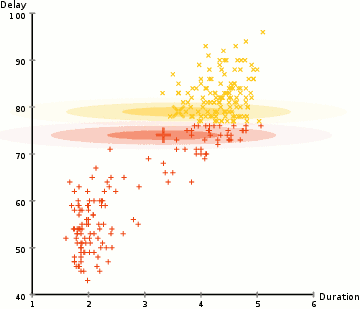5 Types of Deep Learning Algorithms Explained
Types of deep learning algorithms are; multilayer perceptrons, convolutional neural networks, recurrent neural networks, long short term memory networks, and radial basis function networks.
This article discusses the types of deep learning algorithms, as follows;
1). Multilayer Perceptrons (as one of the Types of Deep Learning Algorithms)
Multilayer perceptron (MLP) is a deep learning algorithm comprising of three distinct data layers, namely; input, output, and hidden layer, which work together simultaneously to create a continuous stream of usable information from multiple datasets [2].
The MLP is an example of a feed forward neural network, because it processes data in only one direction; which is from input to output.
As a result, the multilayer perceptron algorithm is most effective for linear data that has a definite structural outlay. However, it can also process and utilize non-linear data.
The information produced by MLP is usually classified using singular criteria that link large volumes of datasets to each other.
Multilayer perceptron algorithm is recommendable especially in cases that involve significant amount of highly-similar and interconnected data; where a single-unit output per dataset can suffice.
An example of multilayer perceptron usage is the classification and juxtaposition of geospatial data on a temporal basis, to identify visual differences that could help in projects like environment remediation.
For such uses, the MLP algorithm develops a linear deep learning model that analyzes multiple data layers, identifies key features, and spots unique attributes that can be used to link and classify datasets.

2). Convolutional Neural Networks
A convolutional neural network (CNN) is an algorithmic configuration that is based on active and comparative analysis of overlapping datasets, and mostly works with visual data to establish correlations that can be used to solve real-world problems [3].
In simpler terms, convolutional neural networks can be described as deep learning algorithms that directly analyzes and utilizes data without any complex or extensive interpretation.
A convolutional neural network works by collecting data, assigning some definitive attribution (or ‘learning weight’) to the data, and using the information thus derived, to assess other datasets in real time.
An example of convolutional neural network algorithm is linear deep learning model-based image recognition.
Although it is mostly applied with visual data, CNN algorithm can be used tor all forms of data that are readable through real-time computation.
3). Recurrent Neural Networks (as one of the Types of Deep Learning Algorithms)
Recurrent neural networks (RNNs) are deep learning algorithmic systems that are designed and equipped to process temporal data on a sequential and real-time basis. An example of recurrent neural network is natural language processor for speech translation and voice recognition purposes.
Although they have areas of significant similarity, recurrent neural network algorithms differ from convolutional neural networks (CNNs).
The difference between CNN and RNN algorithms is in their data analytic approach and capability; where CNNs are equipped for real-time analysis of distinctive datasets, while RNNs are able to process sequential datasets in real-time, even where there is no significant distinction between the datasets
Like CNN, the recurrent neural network is also a feed-forward algorithm that functions along a singular data-processing pathway.
4). Long Short Term Memory Networks
Long short-term memory (LSTM) network is an advanced variant of the recurrent neural network, which is designed to analyze short term, sequential datasets and consolidate the results to produce long-term usable information.
It is called long short-term memory because the deep learning algorithm in this case uses short-term data to achieve extended-length learning correlations.
LSTM networks are used mainly to learn long-term functionalities based on sequences of short-term data, and it achieves this by identifying and correlating similarities between datasets on a temporal basis, in such a manner that simulates continuity for longer time-periods.
The main advantage of LSTMs is their temporal flexibility, whereby the application of information is not limited to the temporal span of data inputs. LSTM algorithms are also less complex and more versatile than many other kinds of deep learning algorithms.
5). Radial Basis Function Networks (as one of the Types of Deep Learning Algorithms)
Radial basis function (RBF) networks are deep learning algorithms that use spatial non-linear classification to analyze and characterize datasets [1].
The radial basis function algorithm is relatively complex, and assigns a spatial classifier to data based on distance from a given location [4] . It also takes note of the plane (x, y, z) along which a dataset is functioning.
Radial basis functions work by correlating datasets through a curve-fitting mechanism which places the classifying attribute of each data layer in its position within a planar environment, that patterns are identified through analysis of relative positions along a sequential-matching line.

Conclusion
Types of deep learning algorithms are;
1. Multilayer Perceptrons
2. Convolutional Neural Networks
3. Recurrent Neural Networks
4. Long Short Term Memory Networks
5. Radial Basis Function Networks
References
1). Bazargani, M. H. Z.; Pakrashi, A.; Namee, B. M. (2021). “The Deep Radial Basis Function Data Descriptor (D-RBFDD) Network: A One-Class Neural Network for Anomaly Detection.” Available at: https://arxiv.org/abs/2101.12632. (Accessed 2 January 2023).
2). Isabona, J.; Imoize, A. L.; Ojo, S.; Karunwi, O.; Kim, Y.; Lee, C-C.; Li, C-T. (2022). “Development of a Multilayer Perceptron Neural Network for Optimal Predictive Modeling in Urban Microcellular Radio Environments.” Applied Sciences 12(5713). Available at: https://doi.org/10.3390/app12115713. (Accessed 2 January 2023).
3). Mela, C.; Liu, Y. (2021). “Application of Convolutional Neural Networks Towards Nuclei Segmentation in Localization-based Super-Resolution Fluorescence Microscopy Images.” Available at: https://doi.org/10.21203/rs.3.rs-144688/v1. (Accessed 2 January 2023).
4). Wu, Y.; Wang, H.; Zhang, B.; Du, K-L. (2012). “Using Radial Basis Function Networks for Function Approximation and Classification.” ISRN Applied Mathematics 2012(3). Available at: https://doi.org/10.5402/2012/324194. (Accessed 2 January 2022).








